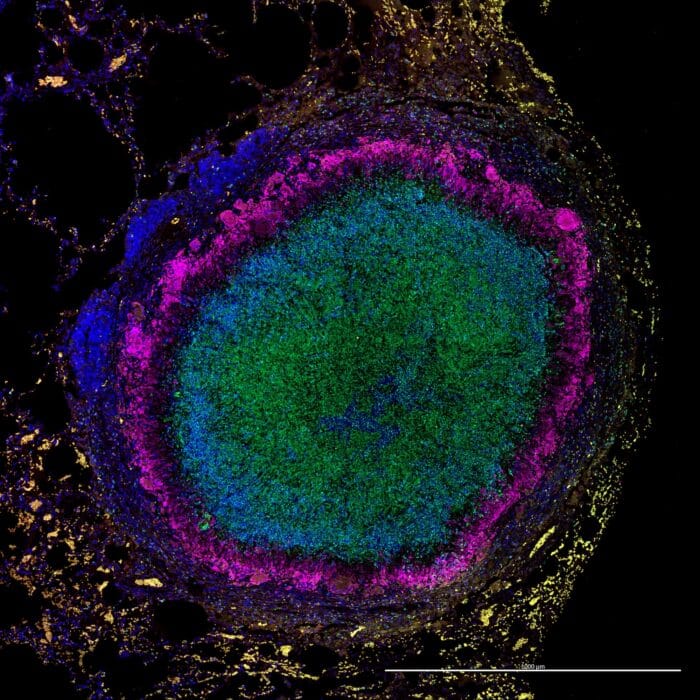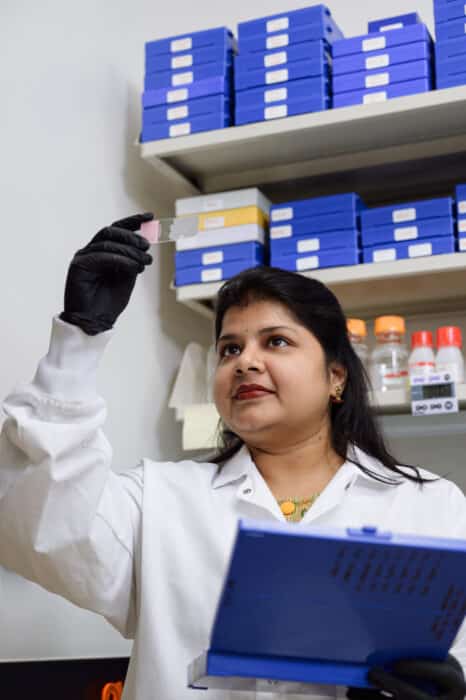SAN ANTONIO (March 31, 2023) — Texas Biomed scientists have identified a promising way to help fight tuberculosis (TB), a disease that still kills nearly 2 million people annually. The research focuses on a potential host-directed therapy targeting the immune system to bolster the body’s ability to control the infection, a method shown to improve cancer treatments.
Specifically, the team found that inhibiting a particular enzyme, known as IDO – short for Indoleamine 2,3 dioxygenase – helped nonhuman primates completely eliminate active TB infection. Blocking IDO for four weeks in conjunction with antibiotics led to improved health metrics compared with antibiotics alone. The findings were reported in JCI Insight.

“This is exciting,” says Texas Biomed Professor Smriti Mehra, PhD, who led the study. “We have promising results suggesting an IDO inhibitor could be a host-directed therapy that reduces the length of time and amount of antibiotics that TB patients have to take, especially those with multi-drug resistance.”
Tuberculosis is still one of the leading causes of death worldwide and among the top two global infectious diseases. Current treatments require patients to take dozens of pills every day for months, sometimes up to a year, to control the bacterial infection. Many of those with TB have a more mild, latent form that reactivates years later after exposure to another illness, such as HIV. The dual infection often proves to be a deadly combination.
Physicians and patients need better treatment options. Professor Mehra and her collaborators have been interested in IDO for many years. IDO is an immune system protein known to suppress other immune responses. Cancer researchers have explored blocking it to improve cancer treatment, while Professor Mehra and her collaborators were the first to document its role in TB in 2018.

In that paper, they found IDO prevents critical immune cells from killing Mycobacterium tuberculosis (M.tb), the bacteria that causes TB. The bacteria are usually found inside circular structures, called granulomas, in the lung. Granulomas are a congregation of immune cells that surround the bacteria.
The team detected a large amount of IDO present in the granuloma’s intermediate myeloid layer. When they blocked IDO production, it reduced IDO levels in the granuloma and the body was able to kill more bacteria. They hypothesize more immune cells are able to enter the granuloma to do their jobs when there is less IDO present.
The JCI Insight paper took that research a step further to see if inhibiting IDO enhances TB treatment. The team, which included researchers, veterinarians and pathologists from Texas Biomed and Southwest National Primate Research Center, compared how groups of macaques with active TB infection fared without treatment, with antibiotic treatment, and with antibiotic treatment plus the IDO inhibitor. The inhibitor was given for four weeks, while a lower-than-usual dose of antibiotics was given for 12 weeks.
The results showed that the animals given the IDO inhibitor did better than those just with the antibiotic treatment.

“The animals given the IDO inhibitor cleared TB completely from the lungs, granulomas and other organs,” says Bindu Singh, PhD, a postdoctoral research fellow at Texas Biomed and first author of the paper. “Most animals given just antibiotics also controlled the infection well, but still had some bacteria in there.”

The research team notes the data were not statistically significant, but it does show potential benefits for clearing infection faster than with antibiotics alone, and could be especially helpful for patients with antibiotic-resistant bacteria.
“Taking antibiotics for months isn’t great for the body, so this is something we are hoping we can advance to reduce the time and high dosage currently required to treat TB,” Dr. Singh says.
There is still much research to be done before moving to human clinical trials, such as clarifying exactly how the IDO inhibitor helps battle TB, how much IDO blocker to give and for how long. The team is also investigating if inhibiting IDO prevents latent TB reactivation in the presence of SIV, the nonhuman primate equivalent of HIV.
“The leading killer of people with HIV is reactivated TB, so if we could reduce TB reactivation levels that would be a very important avenue to explore further,” Professor Mehra says.